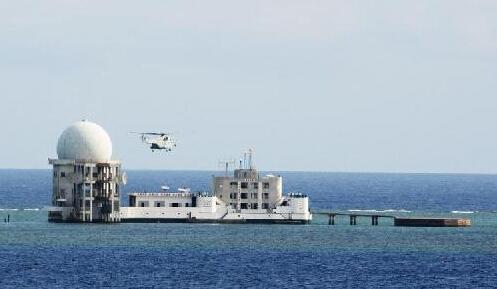
Dual-Use Ships and Facilities Send Mixed Message in South China Sea
Publication: China Brief Volume: 15 Issue: 13
By:

In mid-June, Chinese Ministry of Foreign Affairs spokesperson Lu Kang announced that Chinese land reclamation efforts would soon end, hopefully marking the end of tensions caused by China’s rapid expansion of a number of land features in the South China Sea (MOFA, June 16). Although China’s basic position has not changed–China claims it has undisputed sovereignty over the Nansha islands and other territory in the South China Sea–at the U.S.-China Strategic and Economic Dialogue, Assistant Minister of Foreign Affairs Zheng Zeguang noted that construction on the island, beyond defensive military functions, was primarily for civilian facilities (民事设施) (MOFA, June 25; People’s Daily, May 27).
This framing of the islands and the facilities on them as being for civilian use, rather than purely military oriented, marks China’s move to legitimize its territorial claims. Although, according to Foreign Minister Wang Yi, China is “offering [these facilities] as public goods," the dual-use nature of the facilities means China’s neighbours are unlikely to be mollified (China News Net, June 27). Much of this infrastructure, such as the 3-kilometer (km) long airstrip and harbor constructed at Fiery Cross Reef, is uncomfortably close to the shorelines, cities and military facilities of China’s neighbors.
Further clarification is required about Chinese intentions in the South China and what constitutes civilian use in Chinese terminology. In recent months Beijing has undertaken a series of actions in the region, including the introduction of a draft law that will require civilian ships to adhere to military standards and be available for military use and the labeling of facilities built on reclaimed land in the South China Sea as civilian facilities.
Implicit Military Roles
The reframing of what are in essence military outposts fits into Chinese military tradition and strategic thought that includes the dual military-civilian use of ships, aircraft and facilities (军民融合) (China Brief, June 19). The boundary between civilian and military facilities is far from clear-cut. China’s civilian maritime agency largely acts as part of the Chinese military, and in fact, regularly coordinates with them, as evidenced by a large 2012 joint exercise (International Online, October 19, 2012). The U.S. Department of Defense’s (DoD) latest report to Congress on China’s military power confirms China’s preference for using civilian ships in a primary role, though backed by the Chinese Navy, and notes that China prefers to use its government-controlled, civilian maritime law-enforcement agencies in these disputes (DoD, April 7, pg. 44). This force includes over 200 ocean-going ships, and, as modern aircraft are added, will significant boost China’s ability to monitor the South China Sea (China Brief, May 15). Civilian ships not directly part of a government agency have also been drafted before.
Civilian flagged fishing vessels have long served as surveillance and escalation control mechanisms for the People’s Liberation Army (PLA), and in the future could be used as ISR (Intelligence Surveillance and Reconnaissance) assets or in an anti-submarine role (Defense News, April 17, 2014). China even used an oil rig to help establish its territorial claims by moving Haiyang Shiyou 981 into disputed waters between Chinese and Vietnamese claims last year, and again this year (see China Brief, June 19, 2014; Huanqiu, June 27). Recent policy, however, represents an expansion of this dual role.
According to the Chinese Ministry of Defense, the forthcoming Technical Standards for New Civilian Ships to Implement National Defense Requirements “makes it possible for China to turn the great potential of its civilian ships quickly into military strength for national defense and will considerably enhance the PLA’s strategic projection capability and maritime support capability” (MOD, June 12). What makes this noteworthy is the way that such use of civilian ships has already been integrated into Chinese strategy.
Explicit Military Roles
In June, China held a series of exercises in the South China Sea that, though “unrelated to the present situation” involved responding to “enemy” aircraft and searching for submarines, one of the roles assigned to civilian ships and aircraft during times of crisis (Huanqiu, June 20). The opportunities for these types of missions will only increase due to the ongoing shift towards the maritime domain. As mentioned in the previous edition of China Brief, China’s newest Defense White Paper includes expanded missions for China’s Navy, including open seas protection missions (远海护卫) that would necessitate further coordination between civilian and military vessels (see China Brief, May 29; PLA Daily, May 27). Another authoritative text, The Science of Campaigns, even more explicitly outlines the role of civilian air and maritime assets in aiding amphibious assaults in a chapter entitled “Landing Campaigns.” Reflecting this role, the PLA actively practices using civilian ferries and other ships for invasion scenarios involving Taiwan (Janes, June 16).
As China completes its reclamation work in the South China Seas, the dual-use of facilities, ships and aircraft will create problems for controlling the escalation of conflicts by putting other nation’s navies in the position of confronting “civilian” vessels or conducting flights over “civilian” facilities. As the National Military Strategy of the United States notes, “Overlapping state and non-state violence, there exists an area of conflict where actors blend techniques, capabilities and resources to achieve their objectives” (JCS, July 1, pg. 4) The South China Sea is becoming just such an area.





